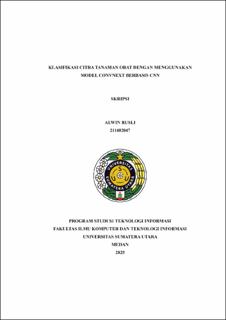| dc.description.abstract | Medicinal plants play a crucial role in traditional medicine in Indonesia due to their natural properties, accessibility, and generational use. One of the most common forms closely related to community life is the family medicinal plants (tanaman obat keluarga or TOGA), which are medicinal plants grown in home gardens to address minor health issues. Despite their benefits, the utilization rate of TOGA remains low due to limited public knowledge and challenges in visually classifying plants, as many species share similar morphological characteristics, potentially leading to misidentification and improper use. This study aims to develop a medicinal plant image classification system using the ConvNeXt model based on Convolutional Neural Network (CNN), optimized through fine-tuning. ConvNeXt was chosen for its modern architecture that combines the computational efficiency of CNNs with the advanced design of transformer-based models, and has demonstrated competitive performance in various image classification tasks. The dataset consists of leaf and flower images from 25 medicinal plant species. The model training process includes data preprocessing, augmentation, data splitting, training and validation, performance evaluation, and conversion to TensorFlow Lite format for implementation in an Android application. Experimental results show that ConvNeXt model achieved the highest testing accuracy of 97.60%, and the accuracy remained high and stable after conversion to TensorFlow Lite. The developed Android application can classify plant images and provide information about their medicinal uses and processing methods. This research demonstrates that ConvNeXt model is effective for medicinal plant image classification and can serve as a tool to help the public in identifying and utilizing medicinal plants safely and accurately. | en_US |


